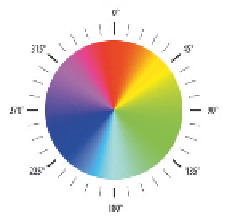HTML and CSS Reference
In-Depth Information
Figure 3-14
HSL color saturation model
hsl(38, 90%, 60%)
90% saturation; 60% lightness
red= 0°
orange at about 38°
+
+
green = 120°
blue= 240°
0%
50%
100%
hue expressed as degrees
on the color wheel
saturation varies
from 0% to 100%
lightness varies
from 0% to 100%
Graphic designers consider HSL easier to use because it allows you to guess at an
initial color based on hue and then tweak the saturation and lightness values to fi ne-
tune the fi nal color. This is more diffi cult in the RGB model because you have to balance
three completely different colors to achieve the right mix. For example, the RGB equiva-
lent to the color in Figure 3-14 would be the color value rgb(245, 177, 61); however, it's
not immediately apparent why that mixture of red, green, and blue would result in that
particular shade of orange.
Opacity Values in CSS3
CSS3 also allows page designers to augment RGB and HSL color values by specifying a
color's opacity. Opacity defi nes how much of the colors below the surface of the current
object show through to affect its appearance. The opacity of a color can be specifi ed
using either of the following
rgba
and
hsla
color values
rgba(
red
,
green
,
blue
,
opacity
)
hsla(
hue
,
saturation
,
lightness
,
opacity
)
where
opacity
sets the transparency of the color as a decimal ranging from 0 (com-
pletely transparent) up to 1.0 (completely opaque). For example, the following style
displays the text of
h1
headings in a medium shade of orange at 70% opacity:
hsla(38, 90%, 60%, 0.7)
With semi-transparent colors, the fi nal color rendered by a browser depends on the
background color of the parent element. Displayed against a white background, this
medium orange color would appear in a lighter shade of orange, while displayed against
a black background it would appear as very dark orange. The advantage of using semi-
transparent colors is that it makes it easier to create a color theme in which similarly
tinted colors are used throughout the page.
The
a
in rgba and hsla
stands for
alpha
and refers
to the alpha channel,
a color concept devel-
oped in the 1970s to
add transparency to the
color model.













































































